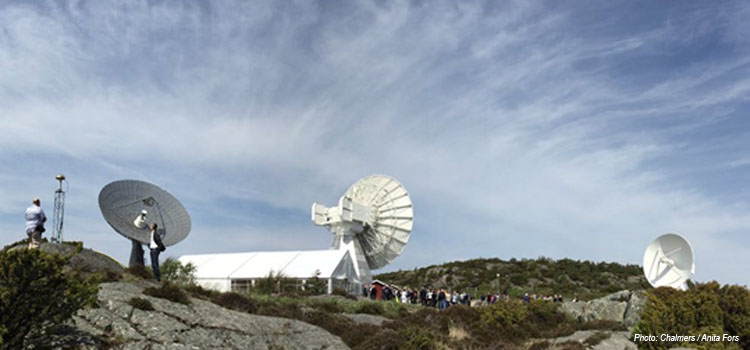
Inauguration of the Onsala Twin Telescopes
The Onsala Space Observatory, Chalmers University of Technology, and the International VLBI Service for Geodesy and Astrometry (IVS) are proud to announce the ceremonial inauguration of a new pair of Twin Telescopes for geodetic and astrometric VLBI. More than 200 international and national guests, including veterans of the first transatlantic VLBI observations in 1968 as well as the regional governors and representatives of Chalmers, participated in the festivity on Thursday, 18 May 2017.
The two new telescopes are equipped with main reflectors of 13.2 m diameter, following the design for the VLBI Global Observing System (VGOS), which is the next generation of the geodetic VLBI network with ultra-fast telescopes and wide recording bandwidth. The twin telescopes will allow continuous observations with at least one of them, but will also permit to exploit innovative observing scenarios with other stations where more than one telescope is available in a compatible observing mode. This offers new possibilities for geodetic and astrometric VLBI research but also investigations of the turbulent behavior of the atmosphere above the observatory.
The new twins join a multitude of co-located instruments at Onsala. Together with the 25 m and 20 m radio telescopes they are part of the Onsala telescope cluster. The Onsala 25 m radio telescope was installed in 1964 and is the first European telescope ever to be involved in VLBI, with first observations in 1968. The radome enclosed 20 m radio telescope was installed in 1976 and has been used with the MarkIII geodetic VLBI system since 1979. Today it has one of the longest time series in the IVS database.
Furthermore, there are a number of co-located instruments for geodetic and geophysical research at Onsala. The GNSS station ONSA was established already 1987 in the CIGNET network, several years before the International GNSS Service (IGS) was founded. ONSA had a pioneering role in the early days of GNSS, and has the longest continuous time series in the IGS network. There is also a gravimeter laboratory with a superconducting gravimeter and a tide gauge site with several independent sensors. The observatory is one of the unique fundamental space geodetic sites that have a direct access to the sea level and co-locate VLBI, GNSS, and gravimetry. It is thus a very important co-location site for IAG’s Global Geodetic Observing System (GGOS).